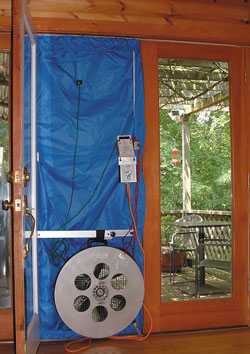A Quick Scrub
Your exterior walls should get a good cleaning. In addition to making your home look great, a wash-down with Log Wash will get rid of the dust, dirt, and grime. Freezing weather is especially hard on log exteriors and a little bit of upkeep now may prevent costly repairs next spring.
Once your walls are clean, go around your home looking for signs of worn stain and failing sealant. If the stain looks faded or dingily, you should consider applying another coat of Lifeline stain and Lifeline Advance topcoat. Don't forget the topcoat is an integral part of the system and will help protect your home and extend the life of your stain.
Finding Air Leaks
Fall is also a good time to seal up any gaps that may be leaking air into the home. As fuel and electricity costs keep going up this becomes especially important. A few air leaks can cost you many dollars per month in keeping your home warm during the winter. The trick is finding and sealing those air leaks before the really cold weather sets in. Here is a system that’s fairly easy and works well.
First you need a cool fall day when the outside temperature is at least 20 degrees lower than the temperature within the home. Next, you want a small pail of warm water, a piece of chalk and a perhaps a ladder depending on how high your ceilings are. Dip your hand in the water then run your wet hand over your interior walls keeping it about six inches to a foot away from the surface.
You will easily feel any cold air leaks that are coming through the walls or around your windows. As you move your wet hand closer to the wall you can pretty well pin-point where the leak is located. Be sure to mark those leaking areas with the chalk.
 If you have a box fan and want an even more efficient method of locating leaks, place the fan in a window or door blowing outward and cover the remaining opening with plastic sheeting. This will help draw cold air into the home through the leaks making them easier to find.
If you have a box fan and want an even more efficient method of locating leaks, place the fan in a window or door blowing outward and cover the remaining opening with plastic sheeting. This will help draw cold air into the home through the leaks making them easier to find.
Sealing the Leaks
Now comes the hard part, sealing up the leaks. The best way to attack leaks is from exterior surfaces. You can seal the interior but if a crack or crevice is leaking air it may also leak water as well. Sealing the leak from the outside prevents water penetration along with air infiltration.
Finding the outside source of the leak may not be as easy as it sounds, especially around window and door frames. The opening source of the leak may be several inches from the spot where it is felt inside the home. You can also hire professionals to find the leaks, just search our Preferred Applicators list for those that do thermographic energy evaluations.
Stops More than Cold Air
In addition to stopping cold air and water from getting inside your home, sealants provide some other benefits. Once the weather turns cool many types of insects start looking for a nice, warm place to spend the winter. Cluster flies (they look like big house flies) can detect warm air coming out of a home from many yards away. They follow the warm air to its source and squeeze through amazingly small cracks and crevices. So, in addition to sealing any openings, you need to check your window and door weather stripping to make sure it’s in good shape.
Come fall, ladybugs and boxelder bugs love to congregate on warm log walls, sometimes in the thousands. They too will enter the home through any small openings. The only effective way to keep them out of the home is to prevent them from getting inside by sealing up their entrance points. Pesticides do not work well against these insects and besides, ladybugs are beneficial insects that feed on aphids and other bugs that can harm your plants and shrubs.
Firewood Storage
Many log home owners have fireplaces or wood stoves that they use to create an attractive atmosphere or as a source of heat. Typically fall is the time of year that most people build their inventory of firewood to carry them through the winter. Here are a few things to keep in mind when storing firewood: Never store firewood on your porch or deck or next to your home. One thing is for certain, along with the firewood comes a whole community of insect pests. Although some like wood roaches, pill bugs, centipedes and ground beetles are harmless, infestations of wood boring beetles, termites, and frequently carpenter ants, can start from stored firewood piles.
Store your firewood at least two feet away from the side of your home and keep it off of the ground. This helps keep the firewood dry and allows air to circulate throughout the wood pile. When you bring firewood inside, only bring in as much as you plan to burn in a day. Firewood stored by the fireplace may look attractive but once the logs warm up and the bugs start to emerge, you may think otherwise.
Preparing your home for winter in the fall can make life so much easier for you in the cold, dark winter weeks ahead. You’ll rest easier knowing that you won’t have to fight the elements when the inevitable emergency or problem crops up, as it always does. You can sit back in front of your fireplace with your family and enjoy those cold months secure in your well-protected home!
Log homes and autumn leaves seem to go together. Enjoy the season and don't hesitate to contact us at 1800-548-3554 or by email at This email address is being protected from spambots. You need JavaScript enabled to view it. if you have any questions about maintaining your log home.
A bit of fall maintenance can make your home look great, reduce the number of bugs you see, and lower your monthly heating bill. Is it worth the effort? You bet it is!

 Fall is a great time of year to do some of those home maintenance chores you’ve been putting off during the hot, summer months.
Fall is a great time of year to do some of those home maintenance chores you’ve been putting off during the hot, summer months.